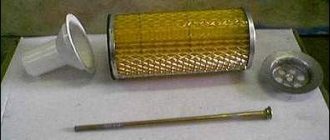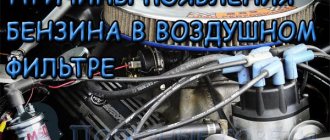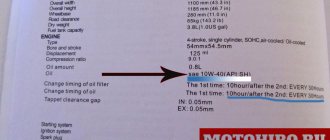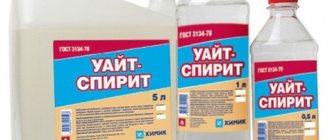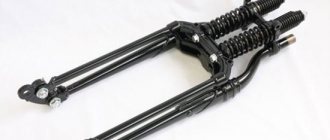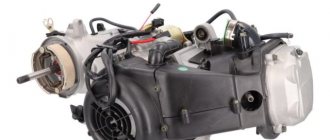001_MOTO_0410_060
Getting to the air filter may require not only skillful hands, but also a good tool.
Getting to the air filter may require not only skillful hands, but also a good tool.
The working mixture—air mixed with gasoline vapor—burns in the engine cylinders. If their masses have a ratio of 14.7:1, the mixture is called stoichiometric (with the correct ratio of parts). If there is more gasoline in it than the “norm”, it is considered rich, and vice versa, a mixture with less gasoline than is needed for a complete reaction with oxygen will be called lean. But the correct composition of the working mixture does not guarantee good engine performance. It is necessary to ensure its constant supply in sufficient quantity.
Here's an example from the world of big racing: an eight-cylinder Formula 1 engine with a displacement of 2.4 liters consumes 450 liters of air per second at a speed of about 18,000 rpm! It is not difficult to calculate that the engine of a modern superbike at maximum power requires about two hundred liters every second. But it's not just big engines that need good air supply. The smaller the engine, the more unwanted losses are felt. That is why for both small 50 cc engines and the most powerful large-volume units, it is extremely important that the condition of the air filter, intake tract, carburetor or throttle body of the injection system is as close to ideal as possible.
Purpose, design and maintenance of the air filter on a scooter
Everyone knows that in a scooter engine, during operation, it is not ordinary gasoline that burns, but a mixture of gasoline and air, prepared by the carburetor in a certain proportion. Gasoline passes through a fine fuel filter before entering the engine, and the air is cleaned by an air filter. If air purification is not carried out efficiently, then small particles of dust (or other contaminants) will quickly cause engine parts to wear out (especially parts of the cylinder-piston group). In addition to cleaning quality, an air filter has another important indicator - air flow resistance. This indicator must strictly correspond to the engine settings, otherwise engine operation will be disrupted.
002_MOTO_0410_061
Remove the filter carefully.
Dirt from the joints tends to fall into the engine. A vacuum cleaner will help remove it in advance. Remove the filter carefully. Dirt from the joints tends to fall into the engine. A vacuum cleaner will help remove it in advance.
A gas mask, respirator, gauze bandage are all options for air filters for people. It's hard to breathe with any of them. And if the bandage is too tight, the lack of air becomes more and more intense, oxygen starvation sets in and your strength leaves you. The same thing happens with a motorcycle engine, because the air supply to it directly depends on the condition of the air filter. Therefore, we should not forget about the important duty of any motorcyclist - to monitor the condition of the “lungs” of his ward.
So, the filter cleans the incoming air, but also makes it difficult to move. The dirtier the filter, the less air reaches the cylinder. Here are some typical manifestations of such a malfunction:
• Power is reduced, which is most noticeable when accelerating from medium speeds.
• When you suddenly open the gas at idle, soot comes out of the muffler.
• Increased fuel consumption within 10%.
• It is possible (if the contamination is very strong) that oil loss will increase. This is due to its suction (through seals and the ventilation system) due to the strong vacuum in the intake tract.
Air filter description types of device operating principle photo video.
The structure of a modern car is such that there are no small details in it. Even those details that at first glance are not particularly important play an important role. For example, an air filter, the importance of which is often downplayed by motorists. In fact, its importance is enormous, because if it is missing or heavily polluted, the normal process of fuel combustion becomes impossible, and the amount of harmful substances contained in the exhaust gases will increase sharply.
To ensure normal combustion of fuel in the cylinders, a huge amount of clean air is required - at least 15 liters for every liter of fuel itself. The air that enters the engine is unsuitable for enriching the fuel mixture without preliminary cleaning, because it contains too many solid particles and other polluting components. Once in the engine, they cause rapid wear of the piston group, bearings and crankshaft. The air filter in a car efficiently removes foreign impurities from the air, increasing the stability of the engine and extending its service life.
003_MOTO_0410_061
The dirtier the filter, the less air reaches the cylinder.
The dirtier the filter, the less air reaches the cylinder.
If the situation is not corrected in time, even greater trouble may occur. A filter clogged with dirt will not withstand the vacuum created behind it and will fall inside the housing. You may not hear it, but the engine, having received a suspended death sentence, will begin to count down the engine hours until its complete death. A rare motor will withstand more than 20 hours of active use without a filter. And, unfortunately, this happens not only to lazy and careless owners. After all, someone, having read in the operating instructions that the air filter must be changed at least once every 20,000 km, flies with a calm heart on their pet. And all around, it’s like in the song: “Poplar fluff, heat, June.” And by seven thousand, the filter is completely clogged with this very fluff... Depending on the place and time of year, the air can be replete with fine sand, steppe dust, plant seeds and even insects. Therefore, the period indicated in the instructions should be taken as the maximum and not be lazy to check the condition of the filter once again (and in Russia there is plenty of dust in large cities, on country roads, and even on highways, where roadsides are often turned into roadways). How to care for the filter depends on its design.
HOW TO CHOOSE THE CORRECT FILTER ELEMENT
If the question - why change the air filter is more or less clear, then many owners simply do not know how to choose an air filter for their car. This is largely due to the manufacturers themselves, who produce a huge number of modifications of devices. The materials of the filter element itself, the shape, degree of filtration, operating conditions, as well as the number of cleaning stages differ. To choose the optimal element, you should first read the recommendations of the vehicle manufacturer - be independent, and changing the type of filter installed is not always possible.
For many car owners, the determining factor when choosing a new air filter is its service life. Most manufacturers are now using increasingly modern materials and technologies so that they have to be changed less frequently, and the degree of air purification remains as high as possible. Despite all the achievements of the developers, it should be understood that almost any “air purifier” will sooner or later have to be replaced with a new one, so you should constantly monitor the engine’s operation, and if specific signs of air shortage appear, it is better to replace the filter element.
Often, many car owners, especially of expensive foreign cars, prefer to purchase not original air filters, the cost of which can be more than five thousand rubles, but cheap fakes. Owners of cars with a turbocharged diesel engine are especially guilty of this, since on such engines the filter replacement interval is more frequent, and its cost is more expensive - this is due to higher requirements in terms of air purification.
It should be understood that any counterfeit air filter does not fulfill its main task, only creating the appearance of protection. In addition to the lack of effective purification of the air entering the engine, counterfeits often and seriously reduce its volume, which leads to over-enrichment of the mixture, a significant increase in fuel consumption, and incomplete combustion of the mixture stimulates the process of premature wear of the main components of any engine.
004_MOTO_0410_061
The Ural filter also requires maintenance: washing and soaking with clean oil every 15 hours.
Fortunately, consumables are inexpensive. The Ural filter also requires maintenance: washing and soaking with clean oil every 15 hours. Fortunately, consumables are inexpensive.
OIL INERTIA , as on old Urals, must be washed in diesel fuel or gasoline every 15 hours of operation, pour fresh oil into the “pan” and soak the metal filter element itself with oil.
005_MOTO_0410_061
The paper filter is the easiest to maintain: we replace it with a new one and move on.
The paper filter is the easiest to maintain: we replace it with a new one and move on.
PAPER FILTERS , which are most widespread in modern technology, are simply replaced with new ones. And, regardless of the instructions in the instructions, it is worth checking their condition at least once every 6–8 thousand km, especially on fast and powerful motorcycles. If the filter is very dusty and there is no replacement at hand, as a temporary measure you can blow it with compressed air from the inside out. When installing the filter, pay attention to its position: the rubberized edges should fit snugly against the plastic body.
006_MOTO_0410_061
“Gauze” (“zero resistance”) requires not only regular maintenance, but also reconfiguration of the power system.
“Gauze” (“zero resistance”) requires not only regular maintenance, but also reconfiguration of the power system.
"GAUZE" FILTERS. When replacing a standard filter with a tuning one, never (unless this is stated in the installation instructions) do not disconnect or change the design of the pipes leading to the filter housing, connecting pipes and any other elements of the intake system.
The filter housing performs several important functions. High-frequency vibrations occur in the intake manifolds of souped-up, high-revving motorcycles, which can either benefit power or cause serious problems. This depends on the setup of the intake system. Everything is important - the size of the air intake hole, the shape of the air filter housing, its volume and, of course, the throughput of the filter itself. The tuning is also complicated by the fact that it is impossible to calculate the exact dimensions of the air duct using formulas and all adjustments require many hours of experiments on engine stands. It can be especially difficult to adjust the intake on multi-cylinder carburetor engines with vacuum-operated dampers. That is why, when replacing a standard filter with a tuning one, it is very important to strictly follow the manufacturer’s instructions. Otherwise, instead of being useful, such a filter may cause harm.
Downloading a book
After successfully completing the payment (by any method) and returning to the KrutilVertel store from the payment system website, you will be taken to the successful payment page:
The book you purchased will be in your personal account, from where you can always download it.
Please note that after making the payment, you need to return back from the payment system website to the KrutilVertel website. If for some reason you did not return back to the site and closed the payment system tab with a message about the successful completion of the payment, please let us know - we will send you a letter indicating access to download the book. If for some reason you did not return back to the site and closed the payment system tab with a message about the successful completion of the payment, please let us know - we will send you a letter indicating access to download the book
If for some reason you did not return back to the site and closed the payment system tab with a message about the successful completion of the payment, please let us know - we will send you a letter indicating access to download the book.
008_MOTO_0410_062
The “zero” filter consists of layers of non-woven material laid between two metal meshes and impregnated with a special sticky oil.
The finest dust simply sticks to the oil, while larger grains of sand get stuck in the gauze. The advantage of this design is the replacement of one dense filter layer with several less dense ones. The engine breathes easier and can add power at high revs. The disadvantage is the need for more frequent maintenance, somewhat less cleaning efficiency and expensive oil and cleaner. The “zero” filter consists of layers of non-woven material laid between two metal meshes and impregnated with a special sticky oil. The finest dust simply sticks to the oil, while larger grains of sand get stuck in the gauze. The advantage of this design is the replacement of one dense filter layer with several less dense ones. The engine breathes easier and can add power at high revs. The disadvantage is the need for more frequent maintenance, somewhat less cleaning efficiency and expensive oil and cleaner.
Any intervention can have a very serious effect on engine performance. Also, never install alarm units, xenon headlight transformers, etc. inside the air filter housing. These warnings are based on life experience. One of my friends, for example, “to lighten the design” threw out the compensation chambers of the intake tract of the carburetor CBR1100XX. At the same time, the piston was bored out on the motorcycle, a sports jet set and a “gauze” filter were installed. After assembly, the motorcycle worked perfectly in place, but when picking up speed it immediately began to become terribly “poor.” Naturally, the reason was sought in the carburetor settings, filter and many other places. However, only the return of the intricately shaped tanks to their place instantly and completely cured the long-suffering “Drozd”.
So, the most popular filters among racers and simply tuning enthusiasts are “gauze”, multi-layer ones (they are also called “zero resistance” filters). They are distinguished from paper ones by the filter material itself and the method of its installation. If the purpose of installing a gauze filter is to improve the dynamic performance of the motorcycle, the following must be taken into account. Replacing a standard (paper) filter with a “gauze” filter without adjusting the carburetors often leads to a deterioration in engine performance, and not vice versa. An engine that receives more air (mainly at medium and high speeds) does not have enough gasoline, and running on a lean mixture, as we know, does not add power. And the carburetor vacuum flaps do not work quite correctly, since they are set at the factory to a different vacuum in the intake manifold. There are kits for adjusting the carburetors of popular sports motorcycles, but you will have to tinker with them if you want to get a really good result - to choose the best combination of jet diameter, needle lift height, quality screw speed.
Most modern motorcycles are equipped with fuel injection, so instead of adjusting the carburetors, you will need to change the injection control program. Companies specializing in tuning sports motorcycles produce programmable control units that allow you to enrich or lean the mixture using a computer, and change the ignition timing. In order not to get lost in the variety of settings, most motorcycles already have preset programs that take into account, among other things, the installation of “gauze” filters. Any intervention in the design of the motorcycle upsets the balance set by the factory engineers, so be prepared to gain in one area (for example, power at maximum speed), but lose in another (for example, traction in the mid-range). However, many people tune their motorcycle “out of love for art.” In this case, the main thing is not to do any harm, and how much the device was actually improved is not so important. Subjective assessment, fueled by the funds spent on your pet, will always be with a “plus” sign. And no measurements at the stand are needed!
MY MOTORCYCLE
What does an air filter mean for a motorcycle? - although this question can be applied to cars, we live in a motorcycle world and therefore we will consider a specific issue. So for many, in principle, giving an answer is not a problem, but that’s not the point. The performance of the entire bike depends on the operation of the air filter. This is the same as a gas mask, a respirator, etc. for us. It's hard to breathe with any of them. And if the bandage is too tight, the lack of air becomes more and more intense, oxygen starvation sets in and your strength leaves you. The same thing happens with a motorcycle engine, because the air supply to it directly depends on the condition of the air filter. From the above, we can conclude that owners of two-wheeled vehicles are simply obliged to monitor the condition of the “lungs” of their ward.
So, the filter cleans the incoming air, but also makes it difficult to move. The dirtier the filter, the less air reaches the cylinder. Here are some typical manifestations of such a malfunction:
• Power is reduced, which is most noticeable when accelerating from medium speeds.
• When you suddenly open the gas at idle, soot comes out of the muffler.
• Increased fuel consumption within 10%.
• It is possible (if the contamination is very strong) that oil loss will increase. This is due to its suction (through seals and the ventilation system) due to the strong vacuum in the intake tract.
“The working mixture burns in the engine cylinders - air mixed with gasoline vapor. If their masses have a ratio of 14.7:1, the mixture is called stoichiometric (with the correct ratio of parts). If there is more gasoline in it than the “norm”, it is considered rich, and vice versa, a mixture with less gasoline than is needed for a complete reaction with oxygen will be called lean. But the correct composition of the working mixture does not guarantee good engine performance. It is necessary to ensure its constant supply in sufficient quantity. Here's an example from the world of big racing: an eight-cylinder Formula 1 engine with a displacement of 2.4 liters consumes 450 liters of air per second at a speed of about 18,000 rpm! It is not difficult to calculate that the engine of a modern superbike at maximum power requires about two hundred liters every second. But it's not just big engines that need good air supply. The smaller the engine, the more unwanted losses are felt. That is why, both for small 50 cc engines and for the most powerful larger units, it is extremely important that the condition of the air filter, intake tract, carburetor or throttle body of the injection system is as close to ideal as possible.”
And if the situation is not corrected in time, a very big “crash” may occur for your motor - a filter clogged with dirt will not withstand the vacuum created behind it and will fall inside the housing. You may not hear it, but the engine, having received a suspended death sentence, will begin to count down the engine hours until its complete death. A rare motor will withstand more than 20 hours of active use without a filter. And, unfortunately, this happens not only to lazy and careless owners. After all, someone, having read in the operating instructions that the air filter must be changed at least once every 20,000 km, flies with a calm heart on their pet. And all around, it’s like in the song: “Poplar fluff, heat, June.” And by seven thousand, the filter is completely clogged with this very fluff... Depending on the place and time of year, the air can be replete with fine sand, steppe dust, plant seeds and even insects. Therefore, the period specified in the instructions should be taken as the maximum and not be lazy to once again check the condition of the filter.
How to care for the filter depends on its design.
1. The Ural filter also requires maintenance: washing and soaking with clean oil every 15 hours. Fortunately, consumables are inexpensive.
2. The paper filter is the easiest to maintain: replace it with a new one and move on.
3. “Gauze” (“zero resistance”) requires not only regular maintenance, but also reconfiguration of the power system.
4. Foam filter - the optimal solution for enduro and cross-country. Excellent dust retention and long service life. You just need to wash it very carefully and not skimp on impregnation.
OIL INERTIA, as on old Urals, must be washed in diesel fuel or gasoline every 15 hours of operation, pour fresh oil into the “pan” and soak the metal filter element itself with oil.
PAPER FILTERS, which are most widely used in modern technology, are simply replaced with new ones. And, regardless of the instructions in the instructions, it is worth checking their condition at least once every 6-8 thousand km, especially on fast and powerful motorcycles. If the filter is very dusty and there is no replacement at hand, as a temporary measure you can blow it with compressed air from the inside out. When installing the filter, pay attention to its position: the rubberized edges should fit snugly against the plastic body.
"GAUZE" FILTERS. When replacing a standard filter with a tuning one, never (unless this is stated in the installation instructions) do not disconnect or change the design of the pipes leading to the filter housing, connecting pipes and any other elements of the intake system. Any intervention can have a very serious effect on engine performance. Also, never install alarm units, xenon headlight transformers, etc. inside the air filter housing. These warnings are based on life experience. One of my friends, for example, “to lighten the design” threw out the compensation chambers of the intake tract of the carburetor CBR1100XX. At the same time, the piston was bored out on the motorcycle, a sports jet set and a “gauze” filter were installed. After assembly, the motorcycle worked perfectly in place, but when picking up speed it immediately began to become terribly “poor.” Naturally, the reason was sought in the carburetor settings, filter and many other places. However, only the return of the intricately shaped tanks to their place instantly and completely cured the long-suffering “Drozd”.
So, the most popular filters among racers and simply tuning enthusiasts are “gauze”, multi-layer ones (they are also called “zero resistance” filters). They are distinguished from paper ones by the filter material itself and the method of its installation.
If the purpose of installing a gauze filter is to improve the dynamic performance of the motorcycle, the following must be taken into account.
CARE OF THE FOAM FILTER: I. You can apply oil with a paint brush. 2. The filter can be washed from engine or transmission oil with soap and water or washing powder. For sticky impregnation, it is best to use a special cleaner or white spirit. 3. We saturate the foam filter with oil, kneading it in the bag.
Replacing a standard (paper) filter with a “gauze” filter without adjusting the carburetors often leads to a deterioration in engine performance, and not vice versa. An engine that receives more air (mainly at medium and high speeds) does not have enough gasoline, and running on a lean mixture, as we know, does not add power. And the carburetor vacuum flaps do not work quite correctly, since they are set at the factory to a different vacuum in the intake manifold. There are kits for adjusting the carburetors of popular sports motorcycles, but you will have to tinker with them if you want to get a really good result - to choose the best combination of jet diameter, needle lift height, quality screw speed.
Most modern motorcycles are equipped with fuel injection, so instead of adjusting the carburetors, you will need to change the injection control program. Companies specializing in tuning sports motorcycles produce programmable control units that allow you to enrich or lean the mixture using a computer, and change the ignition timing. In order not to get lost in the variety of settings, most motorcycles already have preset programs that take into account, among other things, the installation of “gauze” filters.
Any intervention in the design of the motorcycle upsets the balance specified by the factory engineers, so be prepared to gain in one thing (for example, power at maximum speed), but lose in another (for example, in traction in the mid-range). However, many people tune their motorcycle “out of love for art.” In this case, the main thing is not to do any harm, and how much the device was actually improved is not so important. Subjective assessment, fueled by the funds spent on your pet, will always be with a “plus” sign. And no measurements at the stand are needed!
It is advisable to service the “gauze” filter at least every 4-5 thousand km; with careful handling, it can withstand up to 10 oil changes. For flushing you will need a special product (in extreme cases, you can get by with kerosene or white spirit). The oil used to impregnate these filters is usually bright in color. This is no coincidence. The fact is that when impregnating, it is important not to miss a single centimeter of the surface, but also not to overdo it. Uniformly pink or blue white gauze is a sign of a well-saturated filter. At the same time, it is unacceptable for the oil to create a visible shine or, especially, to drip from the filter. In very dusty atmospheres, it is better to use a stickier “cross” oil for foam filters.
FOAM FILTERS are used on many motorcycles, but they are especially popular on enduro and motocross machines, where they work in very difficult conditions. The amount of dust and dirt that they have to hold would be the envy of any vacuum cleaner.
Unlike “gauze” filters, these filters can also be washed in ordinary water and washing powder. But it is better (and more effective, especially if the impregnation is a special, sticky oil) to use branded compounds or white spirit, kerosene, or diesel fuel for cleaning. The instructions strictly prohibit the use of gasoline - and for good reason: it destroys both the material of the filter itself and the adhesive joints in it. And a crumbling filter itself throws debris into the motor and allows dust to pass through. When squeezing the filter from water or solvents, do not twist it, just squeeze it between your palms. And before impregnation, let it dry thoroughly, otherwise the moisture will remain under the layer of oil.
If branded oil is not available, you can use motor oil. True, in this case the degree of purification and water resistance will be slightly reduced (and foam rubber with good impregnation to a certain extent protects against water hammer - unlike air, it passes water with difficulty), and - significantly, about ten times - the service life is up to oil changes. In addition, engine oil does not adhere well to the filter and flows down over time. The car transmission behaves much better. But special oil pays for itself both due to the duration of operation and due to better filtration. So we’ll leave ersatz impregnations for emergency situations.
Impregnating the filter with oil is also a non-trivial task. Beginners make two main mistakes: they saturate the filter unevenly (not only over the area, but also in depth) or overfill the oil, so that after installing the filter it continues to flow out from under the cap for a long time. To prevent this from happening, first carefully pour oil onto the surface of the filter, making sure that it does not leak through (or spray the filter if the lubricant is in a can). As soon as the filter has collected approximately 10-15% of its volume of oil, place it in a transparent plastic bag and gently knead it with your hands, distributing the oil. Impregnation can be considered complete when the filter is evenly colored both outside and inside, and no oil flows out of it when pressed. We squeeze out the excess - we don’t need snot in the airbox, and besides, it can plug the drain valve, an important part on enduro. It is best to let the soaked filter sit for at least a couple of hours, or preferably a day.
And don't forget that air filter oil is sticky, but a foam filter soaked in it feels dry to the touch. And filters coming from the store are sometimes saturated with clear oil. So be careful and don’t get “stuck” like one friend who, out of ignorance, saw a foam filter in a store window, similar in shape to a cap, and immediately pulled it over his head as a joke. It took a good forty minutes to wash the oil out of my hair.
PS
- “The filter housing serves several important functions. High-frequency vibrations occur in the intake manifolds of souped-up, high-revving motorcycles, which can either benefit power or cause serious problems. This depends on the setup of the intake system. Everything is important - the size of the air intake hole, the shape of the air filter housing, its volume and, of course, the throughput of the filter itself. The tuning is also complicated by the fact that it is impossible to calculate the exact dimensions of the air duct using formulas and all adjustments require many hours of experiments on engine stands. It can be especially difficult to adjust the intake on multi-cylinder carburetor engines with vacuum-operated dampers. That is why, when replacing a standard filter with a tuning one, it is very important to strictly follow the manufacturer’s instructions. Otherwise, instead of being useful, such a filter can cause harm.”
- The “zero” filter consists of layers of non-woven material laid between two metal meshes and impregnated with a special sticky oil. The finest dust simply sticks to the oil, while larger grains of sand get stuck in the gauze. The advantage of this design is the replacement of one dense filter layer with several less dense ones. The engine breathes easier and can add power at high revs. The disadvantage is the need for more frequent maintenance, somewhat less cleaning efficiency and expensive oil and cleaner.
- Oil for “cross” filters is very sticky and, as a rule, colored so that the uniformity of impregnation can be controlled.
- According to the principle of operation, foam rubber filters are similar to “gauze” filters, but they are denser and more efficient. An important element of the structure is the supporting frame. Without it, the filter will not work - make sure it is intact! Of course, here you also need to carefully monitor the tight fit in the body. Instead of standard single-layer ones, sometimes double-layer ones with reduced resistance are installed (their outer layer has larger pores). They may also require carburetor adjustments (slightly increasing the main jet and raising the needle). These filters have to be serviced every 2-10 thousand km, depending on conditions
source: MOTO magazine 2010 author Vladimir Tchaikovsky
009_MOTO_0410_062
Oil for “cross” filters is very sticky and, as a rule, colored so that the uniformity of impregnation can be controlled.
Oil for “cross” filters is very sticky and, as a rule, colored so that the uniformity of impregnation can be controlled.
It is advisable to service the “gauze” filter at least every 4–5 thousand km; with careful handling, it can withstand up to 10 oil changes. For flushing you will need a special product (in extreme cases, you can get by with kerosene or white spirit). The oil used to impregnate these filters is usually bright in color. This is no accident. The fact is that when impregnating, it is important not to miss a single centimeter of the surface, but also not to overdo it. Uniformly pink or blue white gauze is a sign of a well-saturated filter. At the same time, it is unacceptable for the oil to create a visible shine or, especially, to drip from the filter. In very dusty atmospheres, it is better to use a stickier “cross” oil for foam filters.
013_MOTO_0410_062
According to the principle of operation, foam filters are similar to gauze filters, but they are denser and more effective.
An important structural element is the supporting frame. Without it, the filter will not work - make sure it is intact! Of course, here you also need to carefully monitor the tight fit in the body. Instead of standard single-layer ones, sometimes double-layer ones with reduced resistance are installed (their outer layer has larger pores). They may also require carburetor adjustments (slightly increasing the main jet and raising the needle). These filters have to be serviced every 2–10 thousand km, depending on conditions. According to the principle of operation, foam filters are similar to gauze filters, but they are denser and more effective. An important structural element is the supporting frame. Without it, the filter will not work - make sure it is intact! Of course, here you also need to carefully monitor the tight fit in the case. Instead of standard single-layer ones, sometimes double-layer ones with reduced resistance are installed (their outer layer has larger pores). They may also require carburetor adjustments (slightly increasing the main jet and raising the needle). These filters have to be serviced every 2–10 thousand km, depending on conditions.
FOAM FILTERS are used on many motorcycles, but they are especially popular on enduro and motocross machines, where they work in very difficult conditions. The amount of dust and dirt that they have to hold would be the envy of any vacuum cleaner. Unlike “gauze” filters, these filters can also be washed in ordinary water and washing powder. But it is better (and more effective, especially if the impregnation is a special, sticky oil) to use branded compounds or white spirit, kerosene, or diesel fuel for cleaning. The instructions strictly prohibit the use of gasoline - and for good reason: it destroys both the material of the filter itself and the adhesive joints in it. And a crumbling filter itself throws debris into the motor and allows dust to pass through.
Practice
Oil-impregnated air filters are now quite common. In terms of their structure and the material from which they are made, these elements are no different from ordinary ones, so you can saturate the filter with oil at home; to do this, follow the algorithm:
Remove the specified element of the air system, disassemble it and remove the foam rubber. If there are cracks, deformations, or tears on its surface, then it is better to replace the filter material with a new one. Dip the foam rubber in a soapy solution (you can use non-aggressive chemical detergents), let it sit for up to 20 minutes, then rinse with water
You should not use gasoline for these purposes; it will dissolve the glue that holds the foam particles together. Please note: you cannot twist or stretch the material, otherwise you will damage it, so wash it carefully and wring it out. Rinse the foam rubber thoroughly, without using high water pressure. Allow the material to dry on its own, without using forced drying: at high temperatures the foam will deteriorate. Lubricate the filter element with oil, it is important that the lubricant is absorbed: there should not be too much of it, it should not drain from the foam rubber. Choose certified products from well-known brands: a low-quality mixture will harm the engine. Remove dirt from the air filter housing. Reinstall the foam in its original place.
In a similar way, filters that use special material in a mesh are washed and lubricated. By applying these manipulations, you will extend the life of your car or motorcycle engine.
011_MOTO_0410_062
The filter can be washed from engine or transmission oil with soap and water or washing powder.
For sticky impregnation, it is best to use a special cleaner or white spirit. The filter can be washed from engine or transmission oil with soap and water or washing powder. For sticky impregnation, it is best to use a special cleaner or white spirit.
When squeezing the filter from water or solvents, do not twist it, just squeeze it between your palms. And before impregnation, let it dry thoroughly, otherwise the moisture will remain under the layer of oil. If branded oil is not available, you can use motor oil. True, in this case the degree of
cleaning and water resistance (and foam rubber with good impregnation to a certain extent protects against water hammer - water, unlike air, passes through with difficulty), and - significantly, about ten times - the service life before changing the oil. In addition, engine oil does not adhere well to the filter and flows down over time. The car transmission behaves much better. But special oil pays for itself both due to the duration of operation and due to better filtration. So we’ll leave ersatz impregnations for emergency situations.
Working principle of the air filter
Basically, for 1 kilogram of fuel, the engine consumes 13-15 kilograms of air, the intake of which occurs outside the vehicle, and also regardless of weather conditions. Because of this, dust, small stones and parts of asphalt, moisture and other substances enter the engine. The filter is designed to clean the air entering the car engine from many harmful impurities.
Over time, with intensive use of the car, the air filter may become clogged with particles of dust or substances, which will significantly reduce the throughput and, accordingly, increase the load on the filter itself, which may become deformed.
For normal engine operation, the frequency of replacing the air filter should be twice a year.
.
As a result, harmful substances and impurities, bypassing the clogged filter, will enter directly into the engine, thereby significantly accelerating wear.
010_MOTO_0410_062
You can apply the oil with a paint brush.
You can apply the oil with a paint brush.
Impregnating the filter with oil is also a non-trivial task. Beginners make two main mistakes: they saturate the filter unevenly (not only over the area, but also in depth) or overfill the oil, so that after installing the filter it continues to flow out from under the cap for a long time. To prevent this from happening, first carefully pour oil onto the surface of the filter, making sure that it does not leak through (or spray the filter if the lubricant is in a can). As soon as the filter has collected approximately 10–15% of its volume of oil, place it in a transparent plastic bag and gently knead it with your hands, distributing the oil. Impregnation can be considered complete when the filter is evenly colored both outside and inside, and no oil flows out of it when pressed. We squeeze out the excess - we don’t need snot in the airbox, and besides, it can plug the drain valve, an important part on enduro. It is best to let the soaked filter sit for at least a couple of hours, or preferably a day.
Pros and cons: is there any sense in “nulevik”?
In reality, the difference with and without a filter is noticed only on a dynamometer stand. The benefit of reducing the resistance of only one element of the intake system appears exclusively in the “full throttle” mode at high speeds; in the standard city driving cycle, the effect of the “zero filter” is exactly zero.
Even for forced engines, reducing intake resistance gives a penny of benefit. Let's take for example a graph taken on a dyno with a Nissan Skyline ECR33, whose RB25DET engine has already moved away from the standard configuration:
The result is not bad - 250 horsepower at the wheels. But, if we remove the air filter altogether - to ensure a reduction in intake resistance even greater than that of a high-quality "zero" - we will get the second graph:
The drop in power after the 5000 rpm peak has become smoother, but the difference in numbers is negligible: its increase without a filter is only 8 horsepower. With 250 hp, which is already there, it is impossible to notice anywhere except on the track, when hundredths of a second count.
And you have to pay for these pennies by complicating maintenance and deteriorating air purification.
In addition, the oil impregnation of “zero” vehicles itself can cause problems on engines equipped with mass fuel flow sensors. The air flow, passing through the filter, carries along microparticles of oil, which then settle on the walls of the inlet pipes and directly on the surface of the sensing element of the mass air flow sensor. Because of this layer, which acts as a heat insulator, the mass air flow sensor begins to “lie”, giving an incorrect signal to the injection computer. And here, based on the “outdated” composition of the air-fuel mixture, the conversation will not be about a microscopic increase in peak power, but about a noticeable drop.
In some cases, the installation of the Federal Tax Service itself can even reduce the maximum engine power. When installing a fashionable cotton “cone” or a foam “mushroom”, you have to dismantle the standard air filter box and air intake. If the layout of the engine compartment is unsuccessful, after this “anti-tuning” the engine does not receive air that is close to atmospheric temperature, but air that is already heated, passing through the radiator. An increase in air temperature for every 10 degrees Celsius gives a loss in density of 0.04 kg/m3 - and an average atmospheric two-liter engine, revved up to 5000 rpm, drives 35 - 40 cubic meters through itself per minute! As a result, an engine with a zero-resistance air filter receives less air mass than with a standard, supposedly “stifled” intake.
An inevitable harm from using zero air filters is accelerated wear of the cylinder-piston group. Even the air purification results of these filters declared by the world's leading manufacturers (for example, K&N) do not exceed 99% under ideal conditions and using expensive branded impregnation oil. The paper curtain air filter is capable of filtering out 99.5 to 99.9 percent of dust. It would seem that the difference is small - but after several tens of thousands of kilometers we will already be talking about the difference in whole grams of dust that gets into the engine cylinders. Moreover, as the paper filter gets dirty, it only increases the degree of filtration: dust, clogging the pores, reduces the flow area, and they become capable of trapping smaller particles, although at the cost of increasing resistance.
In “zero” filters, contamination on the surface of the pores reduces the likelihood of new particles adhering, and the cross section of the pores remains larger than the size of the filtered particles; as contamination increases, the degree of purification decreases with little change in resistance. Previously used contact-oil air filters suffered from the same thing, where oil soaked the fishing line stuffed inside (designs familiar, for example, from old Soviet trucks and motorcycles). “Nuleviks” have become a more compact and lighter version of these filters, which have long been replaced by paper filters.
And errors during filter maintenance only increase the wear rate. Some people manage not to saturate the filters, while others use cheap aerosols or oils that are completely unsuitable for impregnation. Try rubbing a drop of the brand's impregnation oil between your fingers: it's so sticky that it's hard to even wipe it off your fingers. Other oil will not provide any noticeable improvement in cleaning compared to a filter that is not impregnated at all.
The only advantage for engines that have not undergone serious tuning from installing “nuleviks” can be considered the absence of the need for regular replacement: you need to wash and re-impregnate the same filter on time.
012_MOTO_0410_062
We saturate the foam filter with oil, kneading it in the bag.
We saturate the foam filter with oil, kneading it in the bag.
And don't forget that air filter oil is sticky, but a foam filter soaked in it feels dry to the touch. And filters coming from the store are sometimes saturated with clear oil. So be careful and don’t get “stuck” like one friend who, out of ignorance, saw a foam filter in a store window, similar in shape to a cap, and immediately pulled it over his head as a joke. It took a good forty minutes to wash the oil out of my hair.
Carburetor petals and fuel return
When the piston moves from bottom dead center, fuel initially rushes back into the carburetor. On high-speed engines, most often used on motorcycles, a reed valve is used to prevent the air-gasoline mixture from escaping. Valves are:
- metal, characterized by low reliability;
- carbon, expensive, but rarely fail.
Garage craftsmen advise bending the valve petals if it fails. Practice shows that this is only a temporary measure and repairs with replacement of petals are not far off.
Diagnosis is performed by visual inspection. The presence of burnouts or thermal damage or twists indicates the need to purchase a new reed valve.
Despite the unexpected appearance of fuel in the air filter and the inability to start the engine, during operation you should listen to your bike, scooter, or car. Minor malfunctions in engine operation should alert the owner so that in the future he does not see the air filter pouring gasoline onto the ground.


